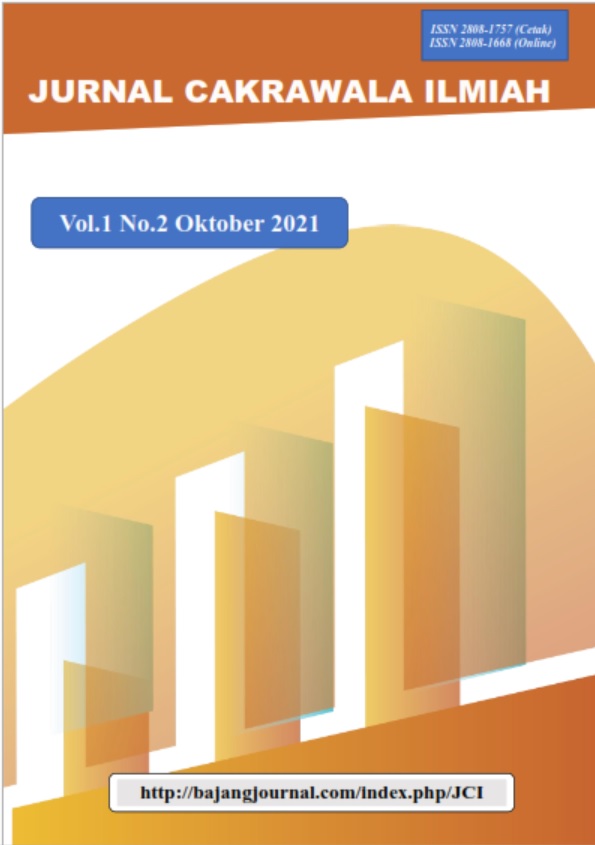GOOD CITIZEN: THE RESPONSIBILITY OF TEACHERS TO SHAPE THE CHARACTER OF MAN 1 SAMARINDA STUDENTS DURING THE COVID-19 PANDEMIC
DOI:
https://doi.org/10.53625/jcijurnalcakrawalaindonesia.v1i2.488Keywords:
Obstacles, Habituation, Teacher's Role, Character Education, Historical Learning.Abstract
This research focuses on the responsibility of PPKn teachers in carrying out their obligations as a professional, guru PPKn is considered to have a very heavy responsibility to the entire community to grow, shape, maintain morals and exist in accordance with Pancasila in the body of the nation's generation. The purpose of this study is to investigate the efforts of VAT Teachers in forming Good Citizen in MAN 1 Samarinda students, whocan form students whoexcel, excel, and at the same time become good citizens. This research uses a type of qualitative deriftive research. Primary data sources from guru and MAN 1 Samarinda students. Data collection techniques use observations, interviews, and documentation. Secondary data sources are obtained from schools with soft files or hard files. Data analysis techniques use miles and huberman models i.e. data collection, data reduction and conclusion withdrawal. The validity of data uses triangulation of data sources. The results of research on upaya conducted by PPKn teachers to attract students, by providing assignments to display skills in the classroom and extra activities of development ofskills outside the classroom. Ppkn MAN 1 Samarinda teachers have made maximum efforts to attract students to PPKn lessons by providing extra learning activities outside the classroom with a variety of activity options but there are still some students who are unable or reluctant to participate in these activities so that the formation of Good Citizen MAN 1 Samarinda becomes hampered. This research can be tested in high school
References
1. Alqurshi, A. (2020). Investigating the impact of COVID-19 lockdown on pharmaceutical education in Saudi Arabia – A call for a remote teaching contingency strategy. Saudi Pharmaceutical Journal, 28(9), 1075–1083. https://doi.org/10.1016/j.jsps.2020.07.008
2. Lian, B., Kristiawan, M., & Fitriya, R. (2018). Giving creativity room to students through the friendly school’s program. International Journal of Scientific and Technology Research, 7(7), 1–7. https://doi.org/10.31219/osf.io/zebpd
Suryaningsi. (2016). Pengoptimalisasian Nilai-Nilai Pancasila Sebagai Upaya Memperkuat Semangat Nasionalisme. 1–14. cholar.google.com/scholar?cluster=8698858680014542916&hl=en&as_sdt=0,5
Warman, Suryaningsih, & Salimdeho, D. (2018). The Nature of Nation Character Establishment Through Educational Local Uniqueness Basis (Elub). 144, 87–89. https://doi.org/10.2991/icedutech-17.2018.16
Arikunto, S. (2006). Metodologi penelitian pendidikan. Yogyakarta: Bina Aksara.
Asfar, AMIT, & Nur, S. (2018). Model Pembelajaran Problem Posing & Solving: Meningkatkan Kemampuan Pemecahan Masalah. CV Jejak (Jejak Publisher).
Astuti, IP (2014). A Sruggle For A Better Life Reflected In Paulo Coelho's Eleven Minuter Novel (2003): An Individual Psychological Approach. 2003.
Avalos, B. (2011). Teacher professional development in Teaching and Teacher Education over ten years. Teaching and Teacher Education, 27(1), 10–20. https://doi.org/10.1016/j.tate.2010.08.007
Baron, C., Sklarwitz, S., & Blanco, MY (2020). Assessment of teachers' gains across multiple historic site-based professional development programs. Teaching and Teacher Education, 93, 103077. https://doi.org/10.1016/j.tate.2020.103077
Dewantara, KH (1977). Pendidikan. Yogyakarta: Majelis Luhur Persatuan Taman Siswa.
Djemari Mardapi. (nd). Penilaian pendidikan karakter.
Girvan, C., Conneely, C., & Tangney, B. (2016). Extending experiential learning in teacher professional development. Teaching and Teacher Education, 58, 129–139. https://doi.org/10.1016/j.tate.2016.04.009
Gore, J., Lloyd, A., Smith, M., Bowe, J., Ellis, H., & Lubans, D. (2017). Effects of professional development on the quality of teaching: Results from a randomised controlled trial of Quality Teaching Rounds. Teaching and Teacher Education, 68, 99–113. https://doi.org/10.1016/j.tate.2017.08.007
Hardy, T. (nd). His Philosoghy and Character in The Mayor of Casterbridge. Journal of Research in Education Sciences.
Hasan, SH (2012). Pendidikan sejarah untuk memperkuat pendidikan karakter. Paramita: Historical Studies Journal, 22(1).
Hasratuddin. (2008). Meningkatkan kemampuan berpikir kritis siswa smp melalui pendekatan matematika realistik.
Huberman, M. & MB (2012). Qualitative data analysis: an expanded sourcebook. SAGE Publications, Thousand Oaks, CA Milhaupt CJ (1996) A Relational Theory of Japanese Corporate Governance: Contract, Culture, and the Rule of Law. Harv Int Law J, 37(1), 3.
Lee, C.-MA (2013). Qualitative Inquiry on Principals' Moral Development and Their Building of Morality and Character in Schools. Journal of Research in Education Sciences, 117–148. https://doi.org/10.3966/2073753X2013035801005
Liou;, S.-MC-MLY-HCC-HF (2015). Survey on Current Implementation of Character and Moral Education and Response to the Curriculum Reform of 12-Year Basic Education in Taiwan. 60(2), 79–110. https://doi.org/10.6209/JORIES.2015.60(2).03
Madya, W., & Pembelajaran, BP (1942). Taksonomi bloom.
Maeng, JL, Malone, M., & Cornell, D. (2020). Student threats of violence against teachers: Prevalence and outcomes using a threat assessment approach. Teaching and Teacher Education, 87, 102934. https://doi.org/10.1016/j.tate.2019.102934
Meissel, K., Meyer, F., Yao, ES, & Rubie-Davies, CM (2017). Subjectivity of teacher judgments: Exploring student characteristics that influence teacher judgments of student ability. Teaching and Teacher Education, 65, 48–60. https://doi.org/10.1016/j.tate.2017.02.021
Moleong, LJ (2002). Metodologi Penelitian Pendidikan. Bandung: Rosdakarya.
Narwanti, S. (2012). Panduan Menyusun Silabus dan Rencana Pelaksanaan Pembelajaran. Yogyakarta: Familia. Diakses Pada Tanggal, 14.
Pendidikan, K., Kebudayaan, DAN, & Isi, D. (2013). Dokumen kurikulum 2013.
Pratama, RA (2019). International Journal of Multicultural and Multireligious Understanding Implementation of Character Education in Historical Learning in the Industrial Revolution Era 4 . 0. 487–496.
Presiden Republik Indonesia. (2005). Undang Undang RI Nomor 14 Tahun 2095 tentang Guru dan Dosen.
Sanjaya, W., & Kompetensi, PDIKB (nd). Metode mengajar merupakan suatu pengetahuan tentang cara-cara mengajar yang dipergunakan oleh seoragn guru atau instruktur. 7 Di dalam.
Alqurshi, A. (2020). Investigating the impact of COVID-19 lockdown on pharmaceutical education in Saudi Arabia – A call for a remote teaching contingency strategy. Saudi Pharmaceutical Journal, 28(9), 1075–1083. https://doi.org/10.1016/j.jsps.2020.07.008
Lian, B., Kristiawan, M., & Fitriya, R. (2018). Giving creativity room to students through the friendly school’s program. International Journal of Scientific and Technology Research, 7(7), 1–7. https://doi.org/10.31219/osf.io/zebpd
Suryaningsi. (2016). Pengoptimalisasian Nilai-Nilai Pancasila Sebagai Upaya Memperkuat Semangat Nasionalisme. 1–14. cholar.google.com/scholar?cluster=8698858680014542916&hl=en&as_sdt=0,5
Warman, Suryaningsih, & Salimdeho, D. (2018). The Nature of Nation Character Establishment Through Educational Local Uniqueness Basis (Elub). 144, 87–89. https://doi.org/10.2991/icedutech-17.2018.16
Theodorus Pangalila. (2017). Peningkatan Civic Disposition Siswa melalui Pembelajaran Pendidikan Kewarganegaraan. 7, 91–103.
Titin Ariska Sirnayatin. (2017). Menbangun Karakter Bangsa Melalui Pembelajaran Sejarah. Jurnal SAP, 1(3), 312–321.
Tukidi, T., & Purnomo, A. (2018). Implementasi Pendekatan Saintifik Mata Pelajaran IPS pada Forum Guru Ambarawa. HARMONY, 3(1), 86–90.
















